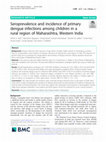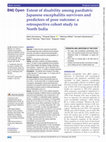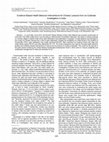Papers by Avinash Deoshatwar

BMC Infectious Diseases, Apr 2, 2019
Background: Dengue infections have become a huge threat to public health systems in developing co... more Background: Dengue infections have become a huge threat to public health systems in developing countries. Data on seroprevalence and incidence of dengue infections are lacking from rural regions of India. The objective of present study was to investigate the seroprevalence and incidence of dengue infection utilizing repeated serosurveys from a rural region of Maharashtra, Western India. Methods: In the present study, 819 children between ages 5 to 15 years from 21 villages in Pune District of Maharashtra, India were sampled in 2014 and 2016. The sera were tested for the presence of dengue specific IgG using an indirect IgG ELISA kit. Results: Overall seroprevalence of dengue was 15.3% (95% confidence intervals (CI) 12.9-17.8%) in 2014 and 20.5% (95% CI 17.8-23.4%) in 2016. Among the 694 children who were seronegative at baseline (2014), 78 seroconverted. Overall incidence rate of primary dengue was 54.2 infections/1000 children years (95% CI 43.0-67.3). Incidence of primary dengue infection was higher in children from urbanized villages compared to rural villages (Incidence rate ratio (IRR) 2.6 (95% CI 1.3-5.2)). In rural villages, incidence of primary dengue infection was higher in children aged 10 years or above as compared to those aged below 10 years (IRR 9.75 (95% CI 1.21-77.9). Conclusions: The study provides the incidence rates of primary dengue infections from a rural region of India. More multi centric studies investigating the incidence of dengue will provide accurate estimate of incidence of dengue and help formulate well directed policies. The results also suggest that urbanization and transitions in demographic settings might favour dengue outbreaks in rural regions and these regions need to be targeted for vector control measures.

PubMed, Jul 28, 2017
Background & objectives: Dengue is highly prevalent in tropical and subtropical regions. The prev... more Background & objectives: Dengue is highly prevalent in tropical and subtropical regions. The prevalence of dengue is influenced by number of factors, i.e. host, vector, virus and environmental conditions including urbanization and population density. A cross sectional study was undertaken to determine the seroprevalence of dengue in two selected villages that differed in the level of their urbanization and population density. Methods: Two villages with demographically well-defined populations close to Pune, a metropolitan city of western India, were selected for the study. Age stratified serosurvey was carried out during February to May 2011 in the two villages-a rural village A, located 6 km from the national highway with a population density of 159/km2 ; and an urbanized village B, located along the highway with a population density of 779/km2 . Assuming a low seroposi- tivity of 10%, 702 serum samples were collected from village A. Sample size for village B was calculated on the basis of seropositivity obtained in village A, and 153 samples were collected. Serum samples were tested for the presence of dengue virus (DENV)-specific IgG. Simple proportional analyses were used to calculate and compare the seroprevalence. Results: Of the 702 samples collected from village A, 42.8% were found positive for anti-DENV IgG. A significantly higher seropositivity for DENV (58.8%) was found in village B. In village A, there was an age dependent increase in seroprevalence; whereas, in village B, there was a steep increase from 17% positivity in 0-10 yr age group to 72% in the 11-20 yr age group. The seroprevalence was almost similar in the older age groups. Interpretation & conclusion: The observations suggested that prevalence of dengue is probably associated with urbanization and host population density. Areas that are in the process of urbanization needs to be monitored for prevalence of dengue and its vector, and appropriate vector control measures may be implemented.
Indian Journal of Medical Research

Journal of vector borne diseases, 2017
BACKGROUND & OBJECTIVES Dengue is highly prevalent in tropical and subtropical regions. The preva... more BACKGROUND & OBJECTIVES Dengue is highly prevalent in tropical and subtropical regions. The prevalence of dengue is influenced by number of factors, i.e. host, vector, virus and environmental conditions including urbanization and population density. A cross sectional study was undertaken to determine the seroprevalence of dengue in two selected villages that differed in the level of their urbanization and population density. METHODS Two villages with demographically well-defined populations close to Pune, a metropolitan city of western India, were selected for the study. Age stratified serosurvey was carried out during February to May 2011 in the two villages-a rural village A, located 6 km from the national highway with a population density of 159/km2 ; and an urbanized village B, located along the highway with a population density of 779/km2 . Assuming a low seroposi- tivity of 10%, 702 serum samples were collected from village A. Sample size for village B was calculated on the ba...

BMC Infectious Diseases, 2019
Background: Dengue infections have become a huge threat to public health systems in developing co... more Background: Dengue infections have become a huge threat to public health systems in developing countries. Data on seroprevalence and incidence of dengue infections are lacking from rural regions of India. The objective of present study was to investigate the seroprevalence and incidence of dengue infection utilizing repeated serosurveys from a rural region of Maharashtra, Western India. Methods: In the present study, 819 children between ages 5 to 15 years from 21 villages in Pune District of Maharashtra, India were sampled in 2014 and 2016. The sera were tested for the presence of dengue specific IgG using an indirect IgG ELISA kit. Results: Overall seroprevalence of dengue was 15.3% (95% confidence intervals (CI) 12.9-17.8%) in 2014 and 20.5% (95% CI 17.8-23.4%) in 2016. Among the 694 children who were seronegative at baseline (2014), 78 seroconverted. Overall incidence rate of primary dengue was 54.2 infections/1000 children years (95% CI 43.0-67.3). Incidence of primary dengue infection was higher in children from urbanized villages compared to rural villages (Incidence rate ratio (IRR) 2.6 (95% CI 1.3-5.2)). In rural villages, incidence of primary dengue infection was higher in children aged 10 years or above as compared to those aged below 10 years (IRR 9.75 (95% CI 1.21-77.9). Conclusions: The study provides the incidence rates of primary dengue infections from a rural region of India. More multi centric studies investigating the incidence of dengue will provide accurate estimate of incidence of dengue and help formulate well directed policies. The results also suggest that urbanization and transitions in demographic settings might favour dengue outbreaks in rural regions and these regions need to be targeted for vector control measures.

Asian Pacific Journal of Tropical Disease, 2017
The journal implements double-blind peer review practiced by specially invited international edit... more The journal implements double-blind peer review practiced by specially invited international editorial board members. Objective: To investigate the Chikungunya outbreak in rural Talegaon Dhamdhere Town of Pune City in Western Maharashtra in October-November 2012. Methods: Samples were collected from people who experienced fever and joint pains since a month ago. Clinical information was collected and entomological investigations were carried out in affected areas. Blood samples collected from hospital and clinics during the outbreak were tested for CHIKV using IgM ELISA (NIV kit), nested RT-PCR and real time RT-PCR. Age specific attack rates were calculated for the epidemic. Results: The overall attack rate for this outbreak was 4.64/1 000 population. The Breteau Index of the area was 12.0 and Adult House Index was 6.2%. A total of 63.6% samples were positive for CHIKV by either ELISA or PCR. Sequence analysis of the partial E1 gene in 4 representative samples found an alanine residue at position 226 of the E1 protein, showing that the CHIKV strain belonged to the ECSA genotype. Conclusions: The epidemic with low transmission intensity was experienced by this area from the western region of the state. This indicates probability of such outbreaks in areas that have witnessed larger Chikungunya outbreaks in the past. Sero-prevalence studies and surveillance for Chikungunya in wide areas of such regions will help formulate well directed policies.

Transactions of The Royal Society of Tropical Medicine and Hygiene, Oct 24, 2019
Background Hepatitis E, caused by hepatitis E virus (HEV), accounts for 50% of acute hepatitis ca... more Background Hepatitis E, caused by hepatitis E virus (HEV), accounts for 50% of acute hepatitis cases in India. We report an outbreak of hepatitis E in Shimla, India, in 2015–2016. Methods ICMR-National Institute of Virology (NIV), Pune, received two batches of water samples from Shimla in January 2016 to test for the presence of enterically transmitted hepatitis viruses. Subsequently, 57 icterus patients were tested for various markers of hepatotropic viruses, i.e. anti-HEV IgM/IgG, anti-hepatitis A virus (anti-HAV) IgM/IgG antibodies and HEV RNA. Water samples were screened for HEV and HAV RNA followed by phylogenetic analysis. Results Overall, 48/57 patients availing municipal water had evidence of HEV infection, detected by serology and RT-PCR. All the water samples tested positive for HEV and HAV RNA, while the patients were negative for anti-HAV IgM antibody, indicating no recent HAV infection. Phylogenetic analysis confirmed the aetiological agent of the current outbreak to be HEV genotype 1. Conclusions Serology and RT-PCR confirmed HEV as the aetiology of the outbreak. The absence of new cases of hepatitis A, despite the presence of HAV in the water supply, could be due to previously acquired immunity. Sewage contamination of water leading to faecal-oral transmission of HEV still remains a concern, thus emphasising the need for a vaccination/control strategy.
Indian Pediatrics, Mar 12, 2020
S easonal outbreaks of acute encephalitis syndrome (AES) have been occurring in four districts of... more S easonal outbreaks of acute encephalitis syndrome (AES) have been occurring in four districts of Gorakhpur and three districts of Basti division of Uttar Pradesh, India since last four decades [1-3]. These outbreaks occur during monsoon and post-monsoon season every year, with cases peaking during August and September, before declining in late November. Outbreaks predominantly affect children aged less than 15 years and are associated with high case fatality ratios, ranging between 15 to 25% [3,4]. Japanese encephalitis accounts for less than 10% of AES cases, while the etiology of remaining AES cases remained largely unknown [5]. Studies conducted during
Clinical Epidemiology and Global Health, Mar 1, 2023
Clinical Epidemiology and Global Health

BMJ Open
ObjectiveTo determine the Japanese encephalitis (JE)-associated long-term functional and neurolog... more ObjectiveTo determine the Japanese encephalitis (JE)-associated long-term functional and neurological outcomes, the extent of reduced social participation and predictors of poor outcomes among paediatric JE survivors.DesignA retrospective cohort study.SettingLaboratory-confirmed JE-positive paediatric cases (<16 years of age) hospitalised at the paediatric ward of Baba Raghav Das Medical College, Gorakhpur, India, between 1 January 2017 and 31 December 2017, were followed up after 6–12 months of hospital discharge.Participants126 patients were included in the study; median age was 7.5 years (range: 1.5–15 years), and 74 (58.73%) were male.Outcome measuresFunctional outcome defined by Liverpool Outcome Score (LOS) dichotomised into poor (LOS=1–2) and good (LOS=3–5) outcome groups compared for demographic, clinical and biochemical parameters for prognostic factors of poor outcomes. Social participation of patients scaled on Child and Adolescent Scale of Participation score 2–5.Resu...

†<p>Incidences were adjusted for health utilization at non-study facilities using the follo... more †<p>Incidences were adjusted for health utilization at non-study facilities using the following formula: adjusted hospitalization incidence = (unadjusted incidence)/(% of acute medical hospitalizations reported on health utilization survey that occurred at study facilities).</p>*<p>From 2009 and 2010 mid-year population estimates from Vadu HDSS.</p>**<p>Adjustment factor = proportion of acute medical hospitalizations reported on HUS that occurred at study facilities: 0.46 for persons aged <1 year, 0.50 for 1–4 years, 0.78 for 5–14 years, 0.73 for 15–29 years, 0.76 for 30–44 years, 0.68 for 45–59 years, 0.67 for >60 years.</p>***<p>Defined as one or more respiratory symptoms in persons ≥5 years: cough, runny nose, sore throat, breathing difficulty or ear ache.</p><p>Defined as one or more respiratory symptoms in persons <5 years: cough, runny nose, fast breathing, or ear ache.</p
<p>Adjusted annual cumulative incidence of influenza associated hospitalization per 10,000 ... more <p>Adjusted annual cumulative incidence of influenza associated hospitalization per 10,000 population, by age, Vadu, District Pune, India, May 2009–April 2011.</p
<p>Laboratory confirmed influenza-associated hospitalizations by month of disease onset and... more <p>Laboratory confirmed influenza-associated hospitalizations by month of disease onset and influenza type/sub-type, Vadu, District Pune, India, May 2009–April 2011 (n = 665).</p

*<p>% underestimate defined as ((1-estimated hospitalization incidence based on use of the ... more *<p>% underestimate defined as ((1-estimated hospitalization incidence based on use of the given screening definition)/estimated hospitalization incidence based on use of all acute medical hospitalizations as a screening definition) expressed as a percentage).</p>**<p>Influenza-like illness (ILI) was defined as fever and either cough or sore throat.</p>***<p>Acute respiratory illness (ARI) was defined as >1 of the following: cough, nasal discharge, sore throat, or shortness of breath (based on history).</p>†<p>Febrile acute respiratory illness (FARI) was defined as the presence of ARI plus fever.</p>‡<p>For persons >5 years, severe acute respiratory illness (SARI) was defined as the presence of ILI and either shortness of breath or difficulty breathing.</p><p>For children <5 years, SARI was defined as pneumonia or severe pneumonia as defined by the Integrated Management of Childhood Illness guidelines as any of the following: any general danger sign (i.e. unable to drink or breastfeed, vomiting, convulsions, lethargic, or unconscious), chest indrawing, stridor, or fast breathing on examination.</p
1<p>Adjusted hospitalization incidence = (unadjusted incidence)/(% of acute medical hospita... more 1<p>Adjusted hospitalization incidence = (unadjusted incidence)/(% of acute medical hospitalizations reported on health utilization survey that occurred at study facilities).</p>2<p>Adjustment factor = proportion of acute medical hospitalizations reported on HUS that occurred at study facilities.</p
<p>Characteristics of the study population and influenza positivity, by age group, Vadu, Di... more <p>Characteristics of the study population and influenza positivity, by age group, Vadu, District Pune, India, May 2009–April 2011.</p
The National Medical Journal of India, 2019

The American Journal of Tropical Medicine and Hygiene, 2021
ABSTRACT. In rural India, since 2014, the Swachh Bharat Abhiyan (Clean India Mission) has ensured... more ABSTRACT. In rural India, since 2014, the Swachh Bharat Abhiyan (Clean India Mission) has ensured construction of more than 100 million toilets and is now focusing on reinforcement of sanitation behaviors. We report a cholera outbreak in a remote village in western India where open defecation was implicated in causation. A water pipeline was damaged in the vicinity of a stream flowing from a site of open defecation. Despite the availability of a toilet facility in the majority of households (75%), open defecation was widely practiced (62.8%). Many reported not washing hands with soap and water before eating (78.5%) and after defecation (61.1%). The study emphasizes the need for focused health behavior studies and evidence-based interventions to reduce the occurrence of cholera outbreaks. This could be the last lap in the path toward achieving the United Nations Sustainable Development Goal 6, which aims to “ensure availability and sustainable management of water and sanitation for a...










Uploads
Papers by Avinash Deoshatwar